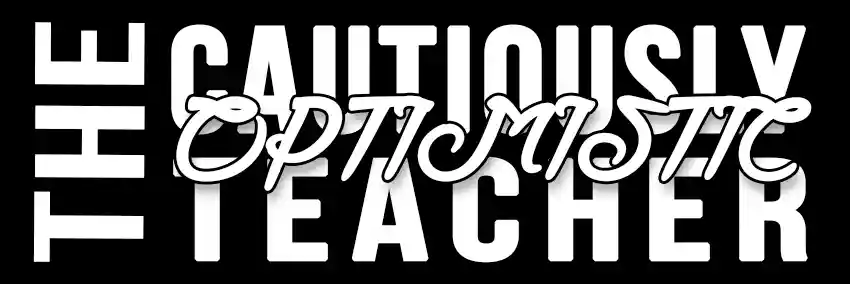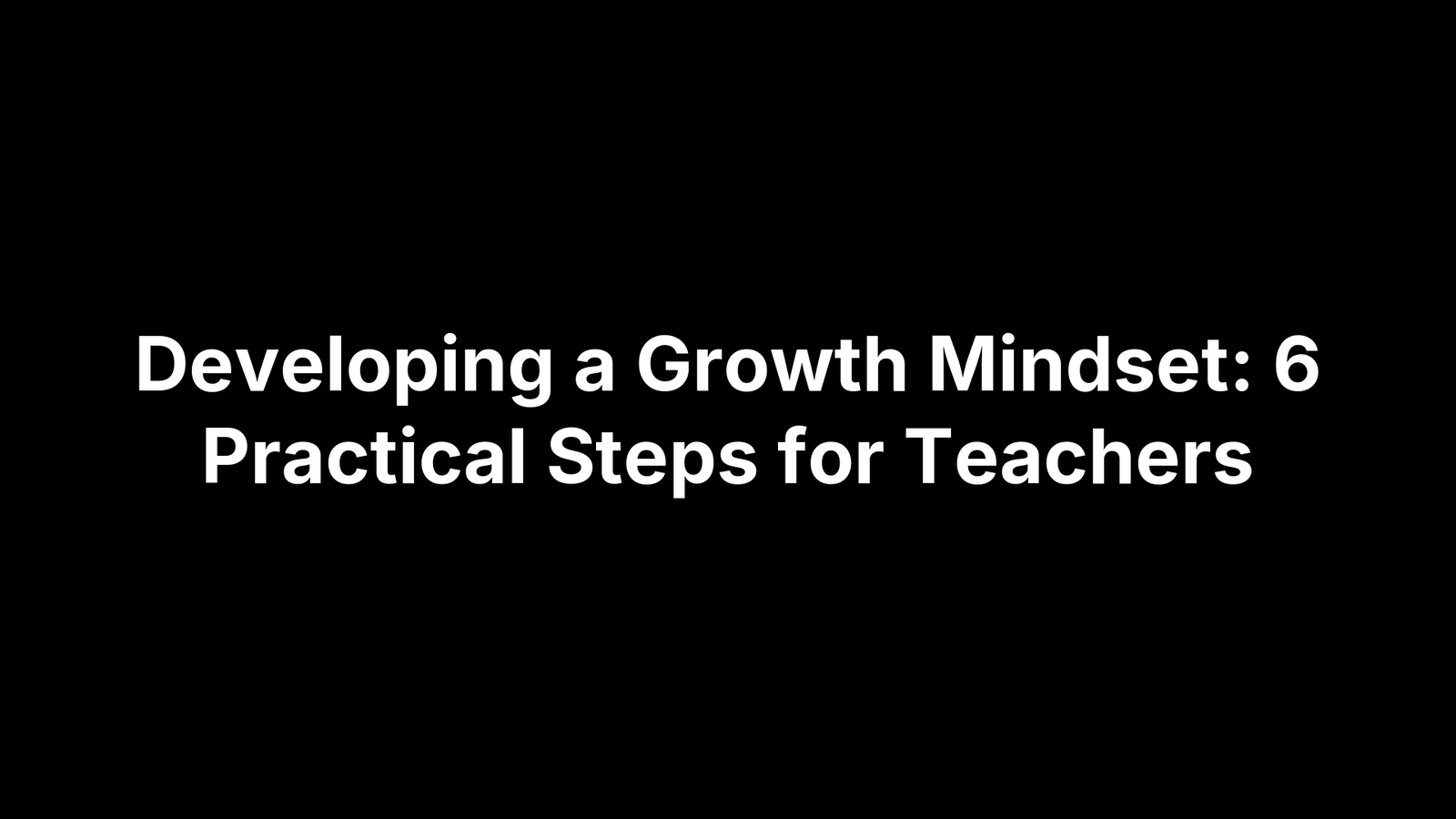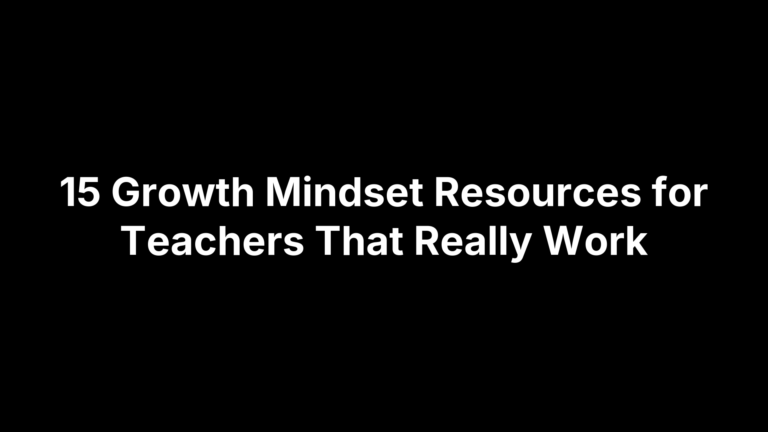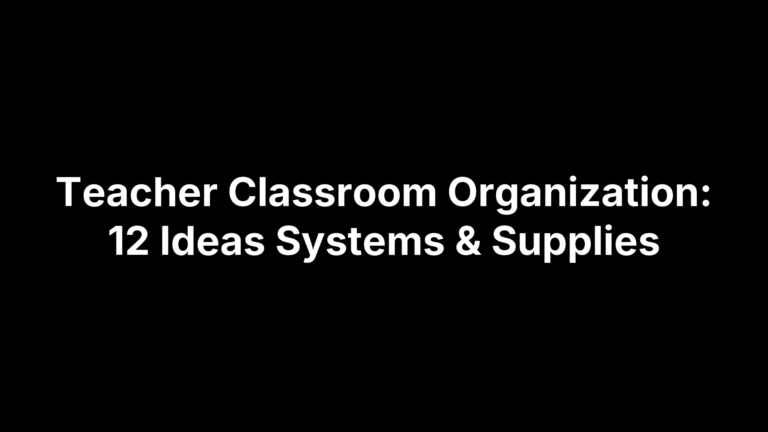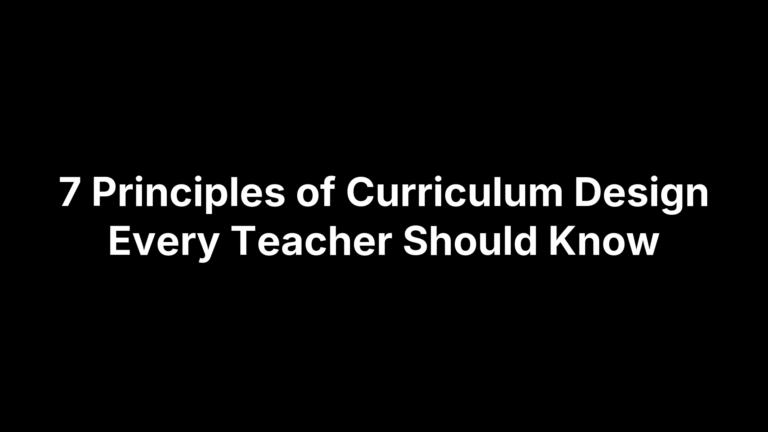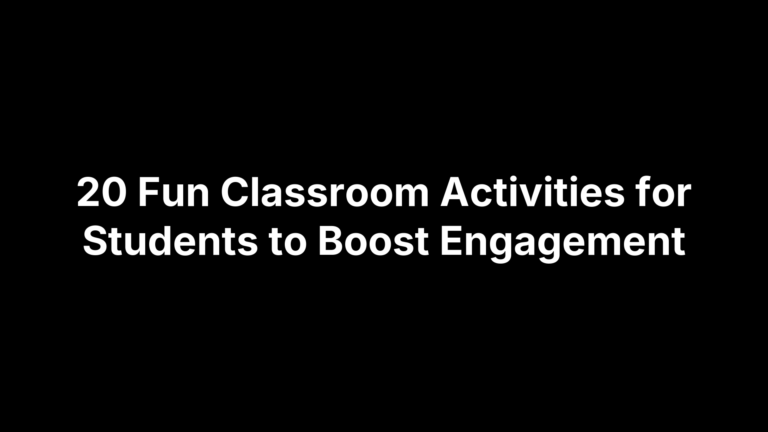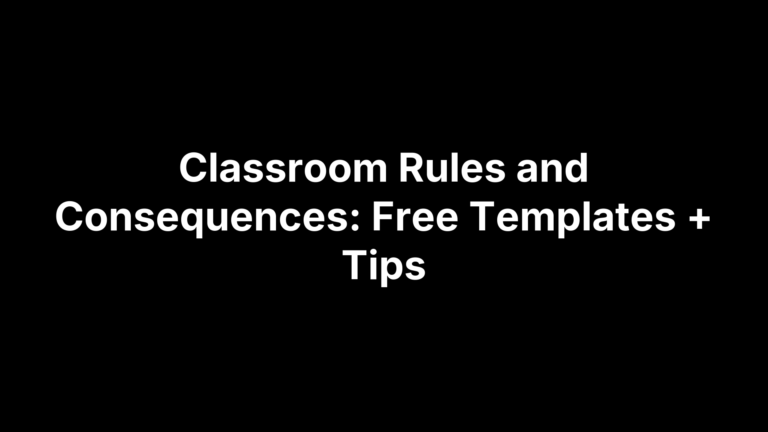Developing a Growth Mindset: 6 Practical Steps for Teachers
You’ve coached students through “I can’t” moments, watched effort stall when grades loom large, and heard the familiar refrain, “I’m just not a math/reading person.” You know posters and pep talks aren’t enough—mindset has to live in your routines, your language, and your assessment system. The challenge is doing that without piling more prep onto an already full plate, and in a way that actually changes how students approach challenge, mistakes, and feedback.
This guide gives you six practical, classroom-ready steps to build a durable growth mindset culture. You’ll get quick scripts to model the language, routines that make metacognition visible, assessment moves that reward strategy over speed, and low-lift tools and templates from The Cautiously Optimistic Teacher to make it stick. Along the way, you’ll see common pitfalls to avoid and examples you can use tomorrow. The goal: help students shift from “proving” to “improving”—and help you do it consistently, efficiently, and with confidence.
1. Jump-start with The Cautiously Optimistic Teacher’s tools and templates
You don’t need to reinvent your syllabus to start developing a growth mindset. Start by plugging ready-made routines, prompts, and templates into what you already teach. This lets you shift language, feedback, and practice fast—without adding hours of prep or sacrificing content coverage.
Why this works
Research on growth mindset shows students improve when teachers make the process visible, praise strategy and effort, and offer chances to revise. Clear routines and templates make those moves consistent: they normalize challenge, invite feedback, and keep focus on improving, not proving.
What to do step-by-step
Build a quick, repeatable cycle you can use weekly.
- Prime: Open with a 2-minute mindset prompt or mini-lesson.
- Practice: Assign tiered practice that invites retries.
- Feedback: Give one process-focused note per student.
- Reflect: Close with a short strategy reflection and next step.
Example language you can use
Swap labels for actions and strategies.
- “Not yet, because…” + one concrete next step.
- “Show me your strategy.” Then coach the process.
- “What changed between draft 1 and 2?”
- “Effort that worked:” name the technique, not the trait.
- “Let’s try a different approach.”
Tools and templates
Use the platform to automate the cycle and keep it visible.
- Brain Builders Workshop: Quick brain + metacognition primers for priming.
- UDL Lesson Plan Template: Plan tiered access and multiple ways to show learning.
- Question Generator: Create reflection stems and error-analysis prompts.
- Worksheet Maker: Build practice sets with space for strategy notes.
- Report Card Commentor: Draft process-praise and “next-step” feedback fast.
- Differentiated Instruction Helper: Tailor practice for “not yet” learners.
Pitfalls to avoid
Avoid the common traps that water down impact.
- Praising effort alone: Name the specific strategy that helped.
- One-and-done talks: Revisit mindset language weekly.
- Only remediation: Offer challenge options to all students.
- Vague feedback: Always tie comments to an actionable next step.
2. Model growth mindset in your language and routines
Students won’t just learn about developing a growth mindset—they’ll catch it from you. Your everyday words and micro-routines either signal “prove you’re smart” or “practice to get smarter.” Research from Stanford’s Teaching Commons points to modeling effort, asking open-ended questions, and praising process (not talent) as levers that build resilience and academic tenacity.
Why this works
When you narrate your own challenges and strategy shifts, you normalize setbacks and center improvement. Dweck’s work shows students with a growth mindset respond to difficulty with constructive thoughts and persistence; your language and structures make those responses the default in your room.
What to do step-by-step
Make growth mindset visible in short, repeatable moves woven into lessons.
- Open with a mindset minute: name the day’s challenge and its purpose.
- Think-aloud struggle: narrate a stuck point and a strategy switch.
- Process-first feedback: give one actionable, strategy-based cue during work time.
- Ask open questions: prompt students to explain how they solved, not just what.
- Revise-and-return: build quick retries to act on feedback before grading.
- Close with reflection: “What worked? What will I try next time?”
Example language you can use
Give students precise, repeatable cues that shift focus to strategy.
- “Not yet, because… Next I’ll try…”
- “Show me where your strategy changed.”
- “What’s one adjustment that could move this from a 2 to a 3?”
- “This challenge is data—what can we learn from it?”
- “Your persistence + [strategy] led to [specific improvement].”
Tools and templates
Keep the language consistent and fast to implement.
- Question Generator: Create open-ended stems and reflection prompts.
- Report Card Commentor: Draft process-focused praise and “next step” notes.
- Worksheet Maker: Add “Strategy Snapshot” boxes to tasks.
- Brain Builders Workshop: Quick primers to frame challenge as growth.
- Differentiated Instruction Helper: Suggest alternative strategies to try.
Pitfalls to avoid
Stay clear of moves that undermine the message.
- Praising effort alone: always name the effective strategy.
- Labels like “smart/fast”: reinforce process, not fixed traits.
- Over-scaffolding: don’t remove productive struggle.
- Inconsistency: routines stick only when used daily.
3. Teach how the brain learns and build metacognition
When students understand that abilities can expand with effective strategies and practice, mistakes become information, not identity. Make learning visible: teach how the brain changes with practice in simple terms, then coach students to plan, monitor, and reflect on their strategies. This keeps developing a growth mindset grounded in daily habits, not posters.
Why this works
Research from Stanford highlights that students who believe intelligence can develop are more resilient and persist through challenge. But, as Dweck cautions, it’s not “effort alone”—students need feedback on strategies and chances to improve. Metacognitive routines give them the tools to respond constructively when work gets hard.
What to do step-by-step
Build a short, repeatable metacognition cycle around your existing tasks.
- Prime (2–3 min): Name the skill and a strategy to try today.
- Plan (before): Students jot “My first strategy” and why it fits.
- Monitor (during): Quick pause: “If stuck, what will I switch to?”
- Analyze (after): Error-analysis: identify the pattern, not just the error.
- Decide (next): Write one concrete adjustment for the next attempt.
- Share: Add effective moves to a visible “Strategy Wall.”
Example language you can use
Keep scripts short and process-focused so students can use them independently.
- “You’re not there yet—what’s your next strategy?”
- “What did this mistake teach you about the task?”
- “Show me where you changed approaches and what happened.”
- “Name the move that helped most today.”
- “One adjustment you’ll try next time is…”
Tools and templates
Use lightweight tools to standardize reflection and save prep time.
- Brain Builders Workshop: Mini-lessons to frame challenge and metacognition.
- Worksheet Maker: Add “Plan → Monitor → Reflect” boxes to any task.
- Question Generator: Create error-analysis and strategy stems fast.
- UDL Lesson Plan Template: Offer multiple strategies and ways to show learning.
- Differentiated Instruction Helper: Suggest alternate approaches when stuck.
Pitfalls to avoid
Avoid mixed messages that undercut metacognition or invite fixed labels.
- Effort-only praise: Always name the specific strategy that moved learning.
- One-off brain talks: Reinforce with daily plan–monitor–reflect routines.
- Over-helping: Don’t erase productive struggle—coach the next move instead.
- Vague reflections: Require an actionable “next try” every time.
4. Design assessment and feedback for growth
Grades shape behavior. If your system rewards speed and first-try accuracy, students will play it safe. If it rewards revision, strategy, and improvement, they’ll lean into challenge. Design your assessments so developing a growth mindset isn’t a slogan—it’s the way success happens in your class.
Why this works
Research summarized by Stanford’s Teaching Commons shows students with a growth mindset persist more and learn more, especially when courses allow multiple drafts, opportunities to respond to feedback, and flexible grading options like revision credit or “slash grades” (e.g., A-/B+). The throughline: align assessment with practice, emphasize process, and make improvement visible.
What to do step-by-step
Build a short teach–try–feedback–revise–reassess loop for major tasks.
- Clarify criteria: Use a single-point rubric centered on strategies.
- Coach once: Give one actionable, process-focused cue mid-task.
- Require revision: Offer a short window to resubmit for improved credit.
- Record growth: Note what changed between drafts and why it worked.
- Align practice: Mirror exam formats to avoid a practice–assessment gap.
Example language you can use
Keep feedback brief, specific, and strategy-forward.
- “Not yet, because… Next, try [strategy].”
- “Your change here—[strategy]—improved [criterion] by…”
- “One adjustment to move this up is…”
- “Show where you revised and what you changed.”
- “Retry using [approach]; report what happened.”
Tools and templates
Standardize the loop without extra prep time.
- Report Card Commentor: Turn process notes into clear next steps fast.
- Worksheet Maker: Add “Revise → Why it’s better” boxes to tasks.
- Question Generator: Create error-analysis and self-assessment prompts.
- UDL Lesson Plan Template: Plan multiple ways to show mastery.
Pitfalls to avoid
Protect the message that improvement matters most.
- Effort-only points: Praise effective strategies, not generic trying.
- First-try finality: Always offer a structured revision path.
- Vague rubrics: Tie feedback to clear, observable criteria.
- Mismatched tasks: Don’t test what you didn’t let students practice.
5. Normalize mistakes and productive struggle
Students learn to avoid risk when mistakes are punished or hidden. Shift the story: errors are information, and struggle is the work of learning. By making mistakes public, safe, and useful—and giving quick chances to apply feedback—you’ll help students see challenge as a path forward, not a verdict.
Why this works
Research on growth mindset shows students persist when they view setbacks as opportunities and get feedback on strategies, not traits. Dweck also cautions: effort alone isn’t enough—students need coaching on what to try next and room to revise so struggle becomes productive, not paralyzing.
What to do step-by-step
Build simple routines that treat errors as data and move learning forward.
- Set a class norm: “Mistakes fuel learning” posted and referenced.
- Model your own error: Think-aloud how you noticed and fixed it.
- Do “Best Mistake” shares: Students present error → fix → lesson.
- Use error analysis: Identify pattern, choose a new strategy, retry.
- Require quick re-attempts: Apply feedback before a final grade.
Example language you can use
Keep it short, neutral, and strategy-forward.
- “Not yet, because… Next I’ll try…”
- “What did this error teach you?”
- “Show where you switched strategies.”
- “This is challenging—by design.”
- “Name one adjustment for next time.”
Tools and templates
Use low-lift tools to standardize error-friendly routines.
- Worksheet Maker: Add “My best mistake” and “Fix + Why” boxes.
- Question Generator: Create error-analysis and re-try prompts fast.
- Brain Builders Workshop: Mini-lessons on challenge and metacognition.
- UDL Lesson Plan Template: Design low-floor, high-ceiling tasks.
Pitfalls to avoid
Protect productive struggle; don’t turn it into sink-or-swim.
- Glorifying grit without guidance: always coach the next strategy.
- Over-scaffolding: don’t remove the challenge students need.
- Public shaming: celebrate insights, anonymize errors when needed.
- Speed worship: avoid time pressure that rewards fast over thoughtful.
6. Set goals, track progress, and celebrate effective strategies
Goals turn “try harder” into “try this next.” When students write specific goals, track small wins, and name the strategies that worked, they see growth as a product of choices they control. Research underscores this: writing down goals improves follow-through, and mindsets shift when feedback spotlights process and revision, not just results.
Why this works
Students with a growth mindset respond to difficulty with persistence and strategy shifts. Visible progress plus process-focused praise builds that response, while Dweck’s cautions remind us to celebrate effective approaches—not effort alone—so students learn which moves actually drive improvement.
What to do step-by-step
Make goal-setting a short, cyclical routine tied to your units.
- Define a 2-week skill goal: Name the skill and a clear success criterion.
- Plan strategies: List two approaches the student will try first.
- Baseline + quick checks: Capture a starting point and 2–3 mini-checks.
- Log attempts: Note date, strategy used, and result in one line.
- Reflect + adjust: Weekly, pick one strategy to keep and one to tweak.
- Show the growth: Share a micro-celebration that names the strategy.
Example language you can use
Give scripts that keep focus on controllable moves.
- “My goal is…, and I’ll use [strategy 1] then [strategy 2] if stuck.”
- “Not yet, because… Next, I’ll try [specific adjustment].”
- “The change that moved me forward was [strategy]—here’s the evidence.”
- “I’m keeping [strategy]; I’ll tweak [strategy] by… next time.”
Tools and templates
Use low-lift tools to make the cycle consistent.
- Worksheet Maker: Build goal trackers with baseline → checks → reflection.
- Question Generator: Create quick “keep/tweak/next” reflection stems.
- Report Card Commentor: Turn logs into precise process feedback.
- UDL Lesson Plan Template: Offer multiple strategies students can select.
- Differentiated Instruction Helper: Suggest next-step approaches by need.
- Brain Builders Workshop: Kick off goal-setting with metacognition mini-lessons.
Pitfalls to avoid
Keep goals actionable and growth-aligned.
- Outcome-only goals: tie goals to strategies and criteria, not just a score.
- Effort praise without guidance: always name the effective move.
- Too many goals at once: limit to one skill focus per cycle.
- No revision window: build in quick retries so tracking leads to change.
Put it into practice
You don’t need a new curriculum to shift mindsets—you need consistent, visible routines. Pick one step from this guide, run it for two weeks, and let students see how strategy, feedback, and revision drive growth. As your language and structures align, the class culture moves from proving to improving—and effort becomes effective effort.
Start this week:
- Pick one routine: Mindset Minute, Best Mistake, or Revise-and-Return.
- Change your talk track: “Not yet, because… Next I’ll try…”
- Require a retry: One actionable cue, one quick re-attempt, one noted change.
Ready to go faster with done-for-you supports? Grab templates and tools from The Cautiously Optimistic Teacher at teachers-blog.com and make growth the way learning happens in your classroom.
